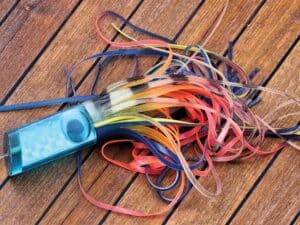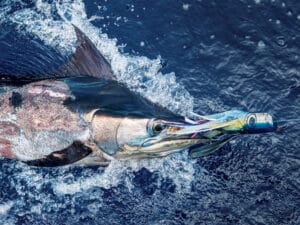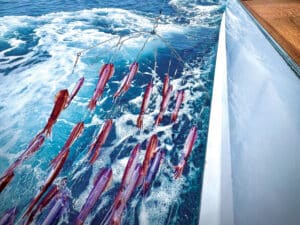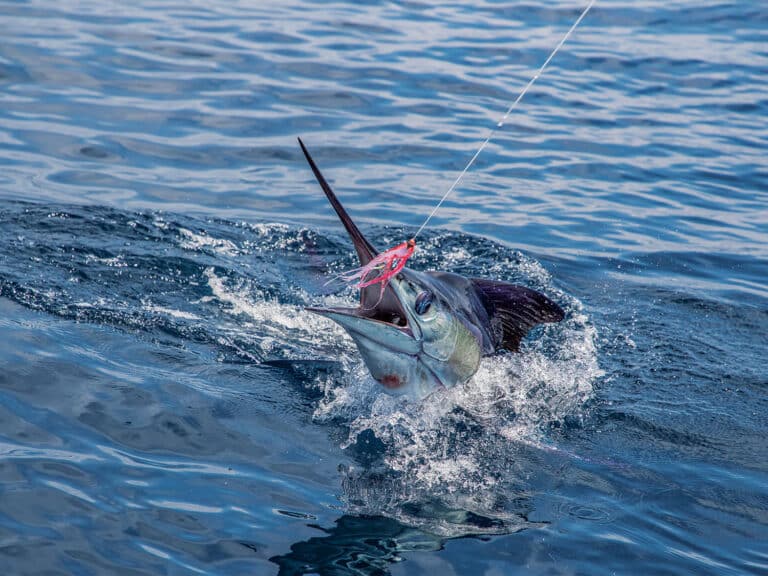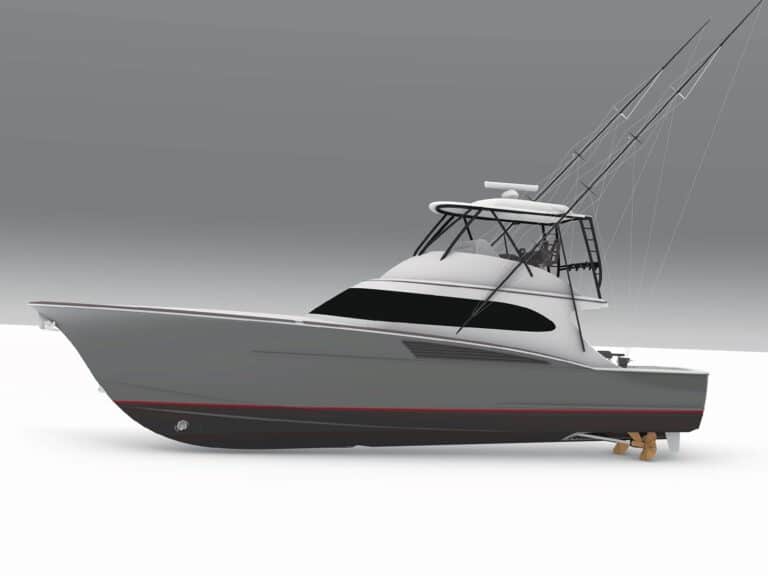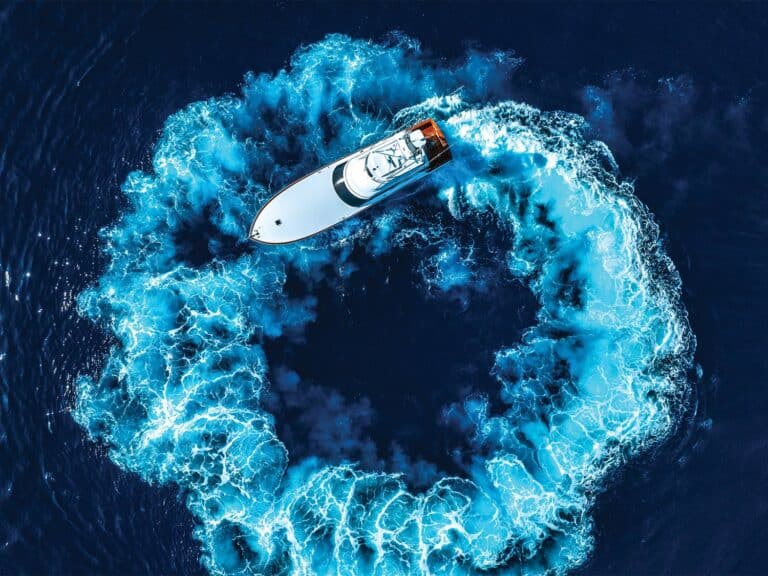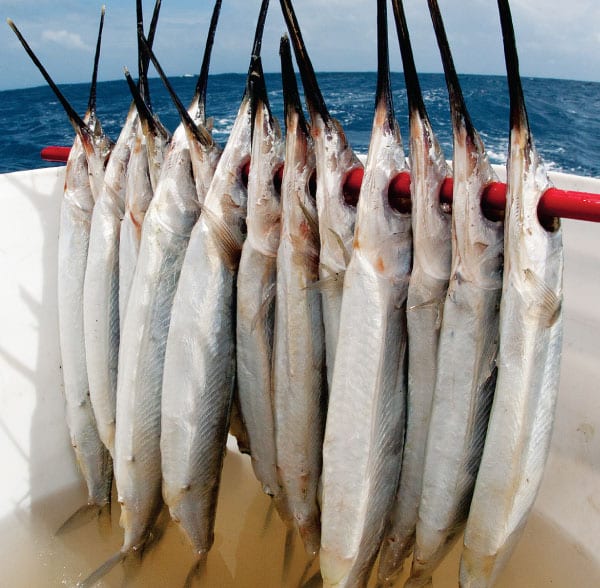
Good fishermen catch fish wherever they go, even when fishing unfamiliar waters. Whether working the pit or handling the rod, Miami sport-fishing captain Ray Rosher and his wife, Charmain, excel at all aspects of the sport. In 2005 and 2006, the pair helped change the time-honored fishing culture of Cabo San Lucas, Mexico, when they achieved back-to-back wins in the hotly contested International Game Fish Association Rolex World Championship Tournament using ballyhoo.
Since they were fishing with Mexican captains accustomed to fishing locally caught baits during the first few days of the 2005 event, Rosher and his four-man team went along with resident fishing customs, pulling lures and pitching live mackerel or cabillitos (scad).
Lagging eight fish off the lead and with nothing to lose, Rosher spoke with the two brothers crewing that day, asking if they might allow him and his wife to rig some baits they brought with them from Miami. The gracious captains agreed and were no doubt wide-eyed when Rosher and a very pregnant Charmain rigged their 40-bait dredge with ballyhoo and launched the fishing kite.
“I’d never caught a striped marlin, so this was new to me. But at the same time, I’m the kind of fisherman that brings everything but the kitchen sink with him no matter where I’m fishing,” Rosher says. In this case, that meant 75 of Baitmaster’s best select-size ballyhoo, deboners, three dredges and fishing kites.
With the ballyhoo dredges attracting scores of striped marlin and the chin-weighted ballyhoo swimming from the flat lines and tinker mackerel skipping from the shotgun riggers and kite, the team made headway fast, catching eight striped marlin to sweep the tournament with 19 billfish. “We made believers out of our crew. They wanted to keep the dredge,” he says.
The next year was a repeat story, with Rosher gently introducing the idea of fishing with ballyhoo and dredges, and voilà, a win with 24 stripes. By his third year fishing the Rolex World Championship, Rosher’s tactics were well understood by Mexican captains, many of whom fished dredges that year for the first time, says Minerva Saenz-Valenzuela of Minerva’s Baja Tackle. “When I came here 35 years ago, guys trolled with rigged flying fish to catch striped marlin,” Saenz-Valenzuela says. “Now, after decades of casting with live mackerel, it’s getting popular again.” So too are dredges.
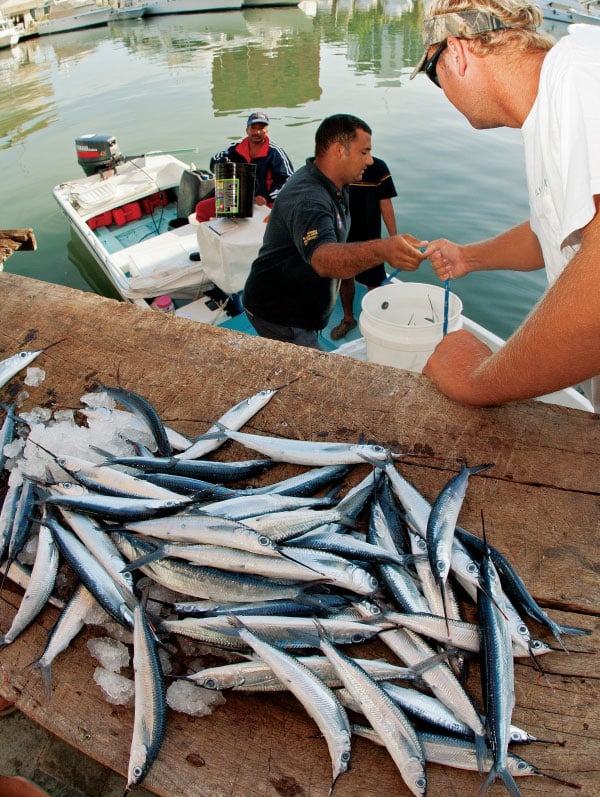
Between high gas prices and sluggish fishing due to La Niña, West Coast fishermen have become more open to dead-bait trolling with ballyhoo, says California dealer Mark Wisch. “Bill DePriest’s success winning the Catalina Classic two years ago in his open 26-foot boat with a spread of ballyhoo has of course had a lot to do with the trend,” Wisch says.
In 2001 Capt. Steve Lassley discovered what East Coast captains have known for decades: that silver-sided ballyhoo deliver dividends when fish are sulky. One of California’s most respected captains, Lassley entered the marlin game during the early ’80s, learning from veteran skippers like Gene Grimes and Ken Dickerson. But those captains were not fans of dead-bait trolling and told Lassley to forget about it.
“They all had reasons for not using dead bait,” Lassley says. “So I didn’t pursue it. Then, 10 or so years ago, I was introduced to dead-bait trolling with ballyhoo by two different East Coast captains fishing with my bosses. The first experience was in a sailfish tournament in Mazatlan on Tenacious. Later, on After Midnite, John Dominick brought ballyhoo, skirts, chuggers and Iland lures on board to try on blue marlin. Dominick, a past winner of the White Marlin Open, taught us how to rig ballyhoo and the importance of having one in the spread.”
The real eye-opener, however, came three years ago during a trip swap between Bad Company and a group of guys from Costa Rica. “These guys were dyed-in-the-wool ballyhoo fishermen, and they brought their own baits with them, which they insisted on using. At first I was reluctant. However, it was one of those days with no bait and no wind, so the fish weren’t showing on top good enough for us to effectively present our live baits, so we indulged them and put out a spread of swimming ballyhoo. Over the next five days of fishing, this group caught 75 striped marlin and a couple of sails, 90 percent of which we caught on the ballyhoo. That showed me the power of ballyhoo,” Lassley says. “More and more West Coast fishermen are dropping their inhibitions about dead-bait trolling and adopting East Coast tricks with dredges and kites rigged with ballyhoo, and are having good success.”
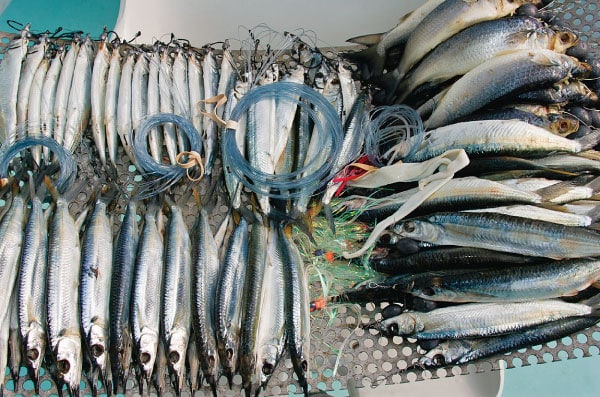
Not as Old as You’d Think
We tend to think of the ubiquitous frozen ballyhoo as having been around forever, but its popularity as a trolling bait is still recent history, even in Florida, where ballyhoo have been used universally only since the early 1970s. When big-game fishing began gaining ground in the 1930s and ’40s, the most popular trolling baits consisted of 8- to 12-inch-long strip baits cut from the bellies of freshly caught silver-sided fish like bonitos, mackerel and blue runners. Anglers also used whole baits like mullet and spots, and, depending on where they lived, squid or sand eels.
In his 1902 book, “Where, When and How to Catch Fish Off Florida,” William H. Gregg suggests using whole grunts, porgies and spots to entice sailfish. Sailfishing pioneer Bill Hatch of Miami first tried catching them on whole mullet before deciding they were too soft for trolling. Fished on the surface, the jerking action of the whippy Calcutta bamboo outriggers would shred baits in short order, so in 1915 Hatch devised a strip-bait-and-safety-pin rig to catch sailfish. Using the proprietary strip-bait spread in 1925, Hatch overwhelmed the competition in the annual Long Key Fishing Camp Tournament in the Florida Keys by catching 113 of the 12-boat tournament’s 229 sailfish that year. Hatch’s overwhelming domination of the tournament changed how billfish are caught.
Robin Thorne started his career as a professional mate in 1958 fishing on Capt. Arthur Robinson’s Vera II out of Pompano Beach, Florida, where the typical sailfish spread consisted of two bonito belly strips, whole silver or finger mullet, and a single ballyhoo. In the beginning, all ballyhoo were fished naked. Blue-and-pink plastic skirts, such as Hoochies and nylon Sea Witches, didn’t come along until the late 1960s, Thorne says.
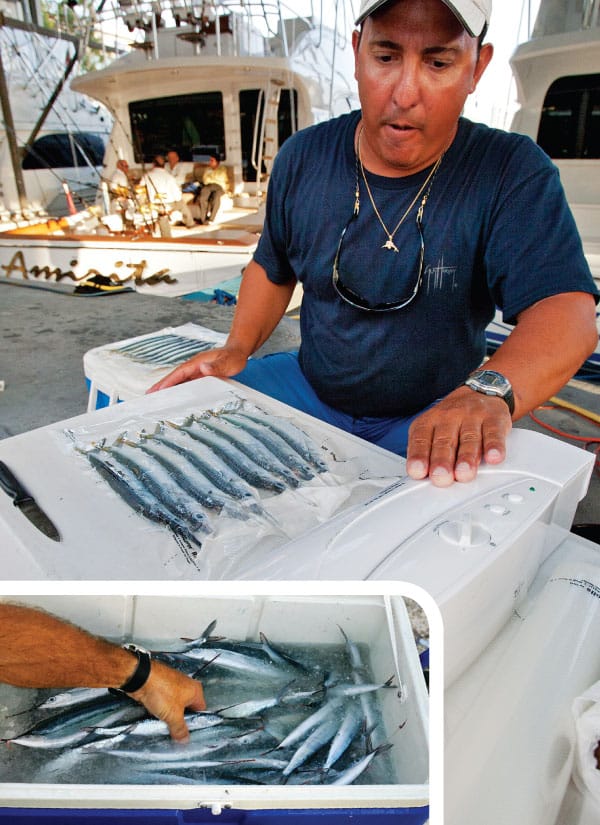
“Charter boats then were owner operated, and captains did not believe in spending money buying bait when they could catch their own. Cast-netting mullet and putting up strip baits was part of a mate’s job description,” says Thorne, now of Fort Pierce, Florida. “Tackle shops then didn’t carry it. If you wanted ballyhoo, you drove to Miami in the winter, where it was available fresh or frozen. Usually, we bought it fresh so we could brine it ourselves overnight to toughen it up. In the winter, Capt. Marvin Griffin out of the Hillsboro docks in Pompano would catch live ones by jigging with gold hook rigs and chumming with oatmeal.”
Since those early days, fishermen have come to regard ballyhoo as nature’s most perfect billfish bait. With upside-down jaws, mirror finishes and non-symmetrical tails, ballyhoo, balao and other halfbeaks are irresistible targets for any game fish, anyplace in the world.
Capt. Billy Harrison started experimenting with ballyhoo in the early 1980s while working at Sodwana Bay, South Africa, to develop the charter-fishing industry there. “This was back when they were trying to catch billfish and tuna in 200 to 2,000 feet of water using 3- to 4-pound bonito and mackerel on cable leaders,” Harrison says. “I was hired to help the fishermen there refine their tackle, teaching them to rig mono leaders, kites, baits and how to find billfish.”
Checking out the fishing scene, Harrison walked out onto a rocky promontory and noticed birds diving on baits that were being dashed by the waves onto the rocks. “I could see they were ballyhoo with greenbacks like we have in Florida,” he says. Inspecting one, he was surprised to find they had parasitic worms in their throat latches just like baits back home. He purchased a cane pole and twisty worms at a local tackle shop and returned, catching three dozen ballyhoo for the next day’s fishing.
After launching from the beach, Harrison talked the captain into fishing in 120 feet of water instead of 1,000 feet and then pulled out his secret weapons and began rigging them on the 80-pound boat rods. The captain was skeptical until Harrison hooked the first sail ever caught off Sodwana Bay some 20 minutes later. Before leaving South Africa, Harrison taught fishermen to rig ballyhoo for sails and striped marlin fishing in 20 to 40 fathoms, and more importantly, how to catch them off the rocks with cane poles. “A fisherman is only as good as his bait,” Harrison says.
Today, Sodwana Bay ranks as a top big-game fishing destination for blue and black marlin, sailfish, and striped marlin not just because the crews learned the techniques to catch them, but because of the mixed coral bottom and turtle grass in the bay that is a natural habitat for ballyhoo.
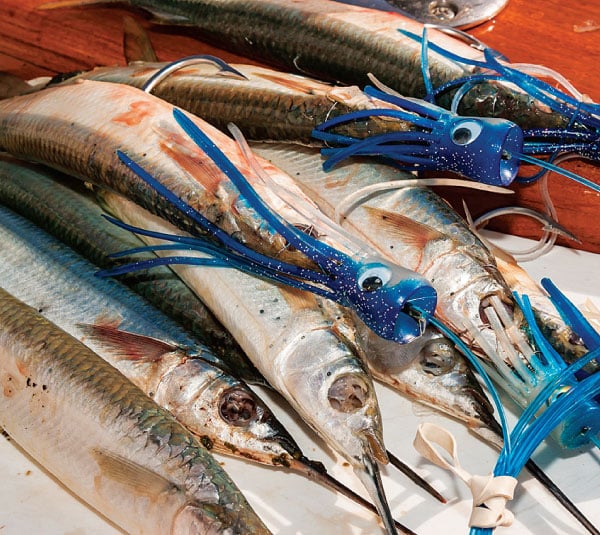
Big Family
The family Hemiramphidae, or halfbeaks, are part of the greater Belonidae group, which includes flying fish, needlefishes and some 85 other species, including the greenback ballyhoo, the blue-backed balao, and Australia’s flying halfbeak, or garfish. And although you will find halfbeaks in all of the tropical and subtropical waters of the world, when it comes to a good trolling bait, not all are created equal.
Among the best-known baits, balao are an oceanic pelagic found from New York to the Gulf of Mexico, as far south as Brazil, and in the Eastern Atlantic from the Canary Islands and Cape Verde to the Gulf of Guinea. Similar in appearance to ballyhoo, balao have blue backs and an orange lower jaw with a red tip. Because of their diet, even when properly brined, balao are softer than ballyhoo. Their skin is more delicate, and although they grow as big as 16 inches in some parts of the world, the average-size balao is 8 to 10 inches.
Among Pacific halfbeaks, ranging from Southern California to Peru, some half-dozen species can be found in Mexican waters. Pacific halfbeaks are distinguished by a single gray stripe running down each side and three dark lines running down the middle of the back. California halfbeaks run smaller, averaging just 6 inches in length.

With their distinctive greenish backs, Atlantic ballyhoo exist throughout the same geographical range as the balao. The preferred habitat of these coastal pelagics is less than 75 feet over mixed bottom, including sand, rock and sea grass. Like other halfbeaks, the sides and belly are silver and the fins yellowish-orange. Averaging 6 to 10 inches, their primary food sources are algae, plankton and sea grass, which explains the distinctive green poop. The low-alkaline diet is what makes ballyhoo the toughest of the three baits, scientists say. Richard McBride, a marine biologist at the National Oceanic and Atmospheric Administration at Woods Hole Oceanographic Center, says that halfbeaks like balao that feed on zooplankton and other types of crustaceans may decompose more quickly due to a more acidic diet, but that has yet to be proven.
Vero Beach marine scientist Dr. Grant Gilmore says that four distinct species of halfbeaks frequent Florida waters, including the common Atlantic ballyhoo, the balao, the false silverstripe halfbeak and the Brazilian halfbeak. The false silverstripe is only found from Cape Canaveral to the mid-Atlantic region, Gilmore says.
Diving with ballyhoo at dark, Gilmore observed something that was not commonly known, a behavior that he says was confirmed later by Australian scientists. Many of the halfbeak species that scientists believed were strictly herbivores, or plant eaters, became opportunistic carnivores at night, when tiny animals invade the water column.
Ballyhoo and balao spawn continually until they die. In the case of ballyhoo, spawning takes place over patch reefs and sea-grass beds from nearshore all the way into Florida Bay, McBride says. The closely related oceanic balao spawns over coral reefs associated with the Gulf Stream. Compared to ballyhoo, which can live up to four years, balao live and die fast — usually within a year. The bulk of the desirable greenback ballyhoo are caught between November and March. Balao (the species that produces red poop) numbers peak between late spring and early summer. Both vanish from the Keys in August, presumably migrating to cooler waters before returning in the fall to repeat the cycle.
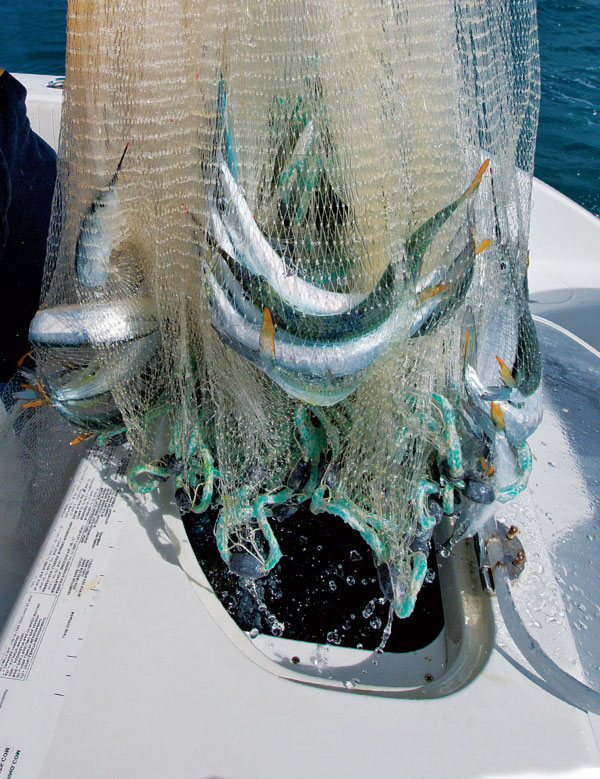
Take Care
Brining is essential to producing long-lasting troll bait. “These are delicate fish, so to prevent the decomposition, it’s essential the bait dies when it’s ice cold in a preservative to prevent discoloration and toughen it up,” says Pat Lynch of Bionic Bait. Bait producers like Bionic Bait, which maintains its own net boats, brine their bait in a mixture of ice, kosher salt, baking soda and a fourth, secret ingredient for up to 10 hours; this process goes on during the hours between when the bait is landed and when it’s trucked to Miami for processing.
Mark Pumo of Baitmasters of South Florida employs a similar approach, explaining that whenever nonbrined bait is frozen, “the meat expands, causing the flesh to separate and tear. That’s why bait gets mushy when thawed,” he says. Both Bionic Bait and Baitmasters sell proprietary brine mixes for fishermen wanting to put up their own baits as well as for use curing defrosted packaged ballyhoo. The mixes contain salt and a bicarbonate of soda. For fishermen creating their own blend, it can be a slippery slope, manufacturers say. Too much salt overtoughens the bait, whereas too little causes the bait to wash out.
Lynch recommends thawing baits in the bag and then arranging them belly side up on a tray in a cooler over a clean, damp towel. Apply a dusting of Bionic Mix or salt over the bellies to draw the moisture out. The amount of brine depends on the quality of the bait. “The softer the bait, the more brine mix you need,” he says.
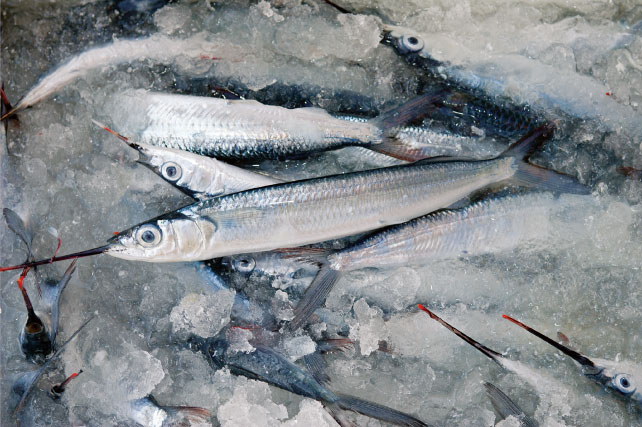
Balao, zooplankton feeders caught primarily on the ocean side of the reef in deep water, have thinner skin and are less desirable to fishermen like Billy Maxwell of Oregon Inlet, North Carolina, who tries to pick through his baits before buying them. Because the two species seasonally mix, sometimes both are taken in a set and packaged, Lynch says, adding that more than 90 percent of the baits he sells are greenback ballyhoo, the baits that Maxwell is after.
North Carolina captains such as Maxwell are the biggest consumers of Florida ballyhoo, buying them by the tractor-trailer at outlets such as the Oregon Inlet Fishing Center, where virtually 100 percent of the more than 38 boats fishing use ballyhoo day in and day out. Because her clientele is so particular, manager Minta Meekins goes to extraordinary lengths to satisfy their preferences, stocking ballyhoo packs from Bionic Bait and Baitmasters. Firm-fleshed, algae-eating smalls and mediums are what Maxwell wants. As an owner-operator, it comes down to dollars and cents, says Maxwell, who goes through a case of 144 baits per day fishing for dolphin, tuna and white marlin. “I’m looking for the most wear out of my baits, especially fishing dredges, which are four packages of mediums to rig. Fishing 250 days a year, it all adds up.”
Large mediums and smalls make up the majority of ballyhoo used by Maxwell and other captains. “Although the smalls are more readily taken by sailfish and white marlin, they wash out quicker, so it’s essential you buy the best quality you can get,” he says. For giant tuna, yellowfins and blue marlin, tougher 10-inch selects and mediums are the preferred bait. Because Maxwell has done his homework, he’s developed a strategy for buying 40 cases of bait that he stockpiles in his home freezer to use as backups for summertime fishing, when the quality of bait is less consistent, he says. Baits available in the summer are more likely to be the red poopers that are not as durable, he explains. Maxwell’s wife, Heather, calls it his bait cellar. Buying packaged bait, he’ll spend 10 minutes going through packages and looking for green poop residue in the bags. “That way, I know I’m getting the best-quality ballyhoo my money can buy.”
